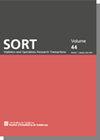使用对数-正态-多项分布建模计数数据
IF 1.2
4区 数学
Q4 OPERATIONS RESEARCH & MANAGEMENT SCIENCE
Sort-Statistics and Operations Research Transactions
Pub Date : 2020-01-01
DOI:10.2436/20.8080.02.96
引用次数: 2
摘要
对数-正态-多项分布是一种计数数据模型,由计数的多项分布与多项事件概率的多元对数-正态分布复合而成。然而,对数-正态-多项概率质量函数不允许一个封闭形式的表达式,因此,参数估计需要数值逼近。在这项工作中,介绍和评估了不同的估计方法。我们得出结论,基于准蒙特卡罗期望最大化算法的估计提供了最佳的整体结果。在此基础上,对dirichlet -多项式模型和对数-正态多项式模型的性能进行了比较。本文章由计算机程序翻译,如有差异,请以英文原文为准。
Modelling count data using the logratio-normal-multinomial distribution
The logratio-normal-multinomial distribution is a count data model resulting from compounding a multinomial distribution for the counts with a multivariate logratio-normal distribution for the multinomial event probabilities. However, the logratio-normal-multinomial probability mass function does not admit a closed form expression and, consequently, numerical approximation is required for parameter estimation. In this work, different estimation approaches are introduced and evaluated. We concluded that estimation based on a quasi-Monte Carlo Expectation-Maximisation algorithm provides the best overall results. Building on this, the performances of the Dirichlet-multinomial and logratio-normal-multinomial models are compared through a number of examples using simulated and real count data.
求助全文
通过发布文献求助,成功后即可免费获取论文全文。
去求助
来源期刊

Sort-Statistics and Operations Research Transactions
管理科学-统计学与概率论
CiteScore
3.10
自引率
0.00%
发文量
0
审稿时长
>12 weeks
期刊介绍:
SORT (Statistics and Operations Research Transactions) —formerly Qüestiió— is an international journal launched in 2003. It is published twice-yearly, in English, by the Statistical Institute of Catalonia (Idescat). The journal is co-edited by the Universitat Politècnica de Catalunya, Universitat de Barcelona, Universitat Autonòma de Barcelona, Universitat de Girona, Universitat Pompeu Fabra i Universitat de Lleida, with the co-operation of the Spanish Section of the International Biometric Society and the Catalan Statistical Society. SORT promotes the publication of original articles of a methodological or applied nature or motivated by an applied problem in statistics, operations research, official statistics or biometrics as well as book reviews. We encourage authors to include an example of a real data set in their manuscripts.
 求助内容:
求助内容: 应助结果提醒方式:
应助结果提醒方式:


